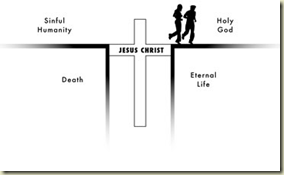Yesterday morning at a men's group I attend, we were discussing 1 Thessalonians 1 which gives a great description of conversion—the response to the Gospel/Good News by which one becomes a Christian.
... our gospel came to you not simply with words but also with power, with the Holy Spirit and deep conviction.... You became imitators of us and of the Lord, for you welcomed the message in the midst of severe suffering with the joy given by the Holy Spirit. And so you became a model to all the believers in Macedonia and Achaia. The Lord's message rang out from you not only in Macedonia and Achaia—your faith in God has become known everywhere. Therefore we do not need to say anything about it, for they themselves report what happened when we visited you. They tell how you turned to God from idols to serve the living and true God...
Is that message ringing out from our churches today? How are we doing at evangelism? Could I say enough to be able to invite a friend to trust in Jesus and to experience the life change I have experienced? John Bowen wrote a great book which aims "to show that evangelism is, or at least can be, normal for all those who consider themselves followers of Jesus" (p.16, Evangelism for "Normal" People). In contrast to those Thessalonians and their ringing message, many of us may resonate more with Rebecca Manley Pippert who confessed, "There was part of me that secretly felt evangelism was something you shouldn't do to your dog, let alone your friend" (p.16, Out of the Saltshaker).
and their ringing message, many of us may resonate more with Rebecca Manley Pippert who confessed, "There was part of me that secretly felt evangelism was something you shouldn't do to your dog, let alone your friend" (p.16, Out of the Saltshaker).
Recently, on a church website, I came across a new way of presenting the gospel called "The Big Story." The author, James Choung, believes we need to go beyond The Bridge illustration which we've used so much in the last few decades (think: Four Spiritual Laws, Steps to Peace with God, or "The Bridge"). Maybe you'll recognize it...
It seems to me, that for many Christians today, this Bridge illustration has become "the bridge to nowhere." We know the plan, we can talk about this bridge if we had to, but we're not actually sharing our faith with others, so it remains just a bridge we could draw if we needed to, not one that people have actually crossed. And a bridge that exists only in our minds, my friends, really is "a bridge to nowhere."
Evangelism is one of the many activities we no longer have time for in our busy, fast-paced world. Ironically, it is in this busy fast-paced world where I've heard more about evangelism in the last couple years than in the church! Evangelism is the sharing of good news, so Tim Sanders believes we should diligently read the latest greatest business books so that we can "evangelize" the best ideas from these books to everyone we know. Sarah Palin and John McCain are showing what mavericks they are by evangelizing Alaska's infamous Bridge to Nowhere which was never built because Palin said "no" to the pork barrel spending of Congress. This "evangelism" that has nothing to do with the Good News of Jesus started with Guy Kawasaki who pioneered the concept of evangelizing a product to promote its sales. Thanks to Kawasaki's plan of evangelism, from the early years of Macintosh computers to today, Apple owners never stop talking about the superiority of their computers! I've been wondering if the church could learn a point or two from a book I've been reviewing titled Creating Customer Evangelists. Everyone seems to be out there evangelizing something! Hopefully, the problem is just me and there really are many, many Christians out there evangelizing the good news of Jesus because we really do have a life-changing message to share. Maybe it's high time to reclaim evangelism for the true gospel of Jesus Christ.
I know one Christian who is doing something—my wife. She told me that her new carpool friend from work is visiting our church this Sunday. I think that's great since they've only just met a short while ago. And, actually, it's really great since this friend is also bringing her boyfriend who hasn't been to church for over five years since leaving a narrow-minded, ultra-conservative church (and I might be tempted to say cult-like group). Last year, my wife invited a friend that she had taken a class with to come to our church's Alpha Course, and she did come because she had been meaning to get around to looking into Christianity! So I do know from my wife's example that some evangelism is taking place. (And as a footnote about myself, I guess I do want to clarify that I am trying to share my faith, but I've had some friends in the last couple years that I just haven't been able to make much progress with.)
I'm hoping to get some feedback on what you think about this new way of presenting our good news. I like that James Choung is trying to stress not just a "decision" but transformation. He talks not just about the "individual" but about the Christian community. And he is less focused on the "after-life" and more focused on our life together on a mission. I really would like to hear what you think about this presentation. (After playing "The Big Story", you'll see a link to play "The Big Story, Part 2" which I recommend as well.) After viewing it, think about, and make a post. Maybe we can talk about it together. Just maybe we should be ready to draw four circles rather than our plan for a bridge which doesn't seem to be leading us anywhere. Let me know what you think.
Related Sermons
Forfeiting Life
God's grace is amazing and even overwhelming at times. But forfeiting the grace that could be ours is not a winning strategy. The book of Jonah offers several "prophetable" insights about the lengths God will go to so that no one forfeits the grace that could be theirs (Jonah 2:8).
Not Ready
This message from John 4:27-42 explores the top reasons why so many of us in the church today believe that we are "not ready" to share our Christian faith. The Samaritan woman from the well instantly becomes an evangelist and her town is changed! What could we learn from this scene in the life of Jesus?
The Gospel according to Canada
There is a rather Canadian way of being a Christian. We value the privatization of religious beliefs. What Jesus says in Mark 4:21-25 challenges our Canadian practice, urging us to make public what is now private.

 Codex Sinaiticus, one of the oldest and most famous Bibles in existence, is indeed written in Greek. Friends of mine were alarmed by a BBC article which claimed that Codex Sinaiticus was "
Codex Sinaiticus, one of the oldest and most famous Bibles in existence, is indeed written in Greek. Friends of mine were alarmed by a BBC article which claimed that Codex Sinaiticus was "